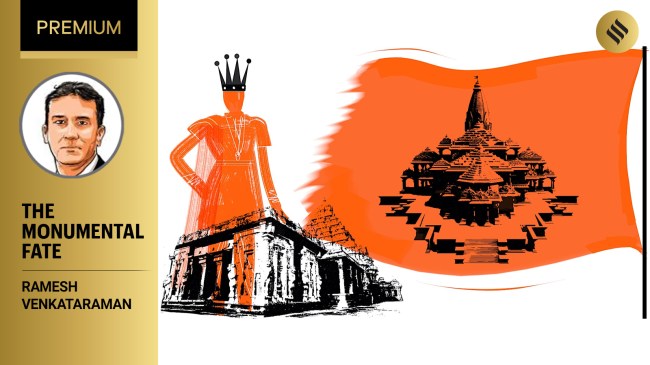Opinion Ram Mandir consecration: Will it get sacred status for Hindus or remain a political project?
Like the imperial temples of yore, it is a monument to the Modi regime’s power and burnishes its Hindu credentials. It also promises to be a major tourist attraction
 Though not perfectly overlapping or consistent, these lists mark the places still regarded as auspicious by Hindus. Even if one accepts that the Ram Janmabhoomi location is the birthplace of Rama and that a temple pre-existed the Babri mosque, present-day Ayodhya does not clearly figure in the conventional tirtha lists. (C R Sasikumar)
Though not perfectly overlapping or consistent, these lists mark the places still regarded as auspicious by Hindus. Even if one accepts that the Ram Janmabhoomi location is the birthplace of Rama and that a temple pre-existed the Babri mosque, present-day Ayodhya does not clearly figure in the conventional tirtha lists. (C R Sasikumar) As the buzz over the Ram mandir builds to a crescendo in the lead-up to its consecration by Prime Minister Narendra Modi on January 22, the new temple is being hailed as many things: A symbol of Hindu civilisational resurrection, just retribution for past wrongs, even a Hindu Vatican. But one critical thing that is unclear, if the history of Hindu worship is any guide, is whether the Ayodhya complex will ever become a sacred pilgrimage destination for Hindus or be just a cultural monument and, in this age of Instagram and Tik Tok, a “bucket list” tourist attraction?
For context, take two major Siva temples in the ancient town of Kanchipuram. One is the Kailasanatha, among the oldest structural temples in south India built around 700 CE (prior temples were either cut out of caves or made of perishable materials such as wood, thatch, or mud). The other is the hoary Ekambareshwar Temple.
The Kailasanatha is an “imperial” temple sponsored by the great Pallava ruler Rajasimha who was also responsible for the famous Shore Temple in Mahabalipuram. The elaborate inscriptions on the central structure tell the story of Rajasimha’s quasi-mythical lineage and accomplishments and, in tandem with the sculptures of various gods and goddesses, propound a convergence of Rajasimha with Siva. The entire site is palpably a monument showcasing Rajasimha’s power and underpinning his legitimacy via divine association.
The Ekambareswarar Temple, on the other hand, is an “organic” temple. The present masonry structures are variously attributed to the Cholas (who succeeded the Pallavas in the Tamil country in the late 9th century), later Vijayanagara rulers, and a local chieftain. But the site itself is celebrated as far back as the hymns of the Tamil Saiva poet-saints of the 6th-9th century. Judging by this and the many charming Puranic myths of Parvati and Siva associated with the locale, it is very likely to have been regarded as sacred and has been a place of worship and pilgrimage for many centuries prior. The spot probably housed a shrine made of makeshift materials that was replaced by the current stone buildings in the medieval era.
Although both the Kailasanatha and Ekambareswarar temples are barely a mile apart and both dedicated to Siva, they couldn’t be further apart on the map of Hindu sacred geography. The Ekambareswarar is a major living shrine, one of the pancha bhoota sthalas revered by south Indian Saivites. The devout throng its grounds, especially on festive occasions, and a posse of priests conduct multiple rituals every day.
The Kailasanatha is by far more impressive and artistically rich than the mishmash architecture of the Ekambareswarar. But it is no more than a heritage attraction maintained by the Archaeological Survey of India. A solitary priest conducts worship at the main sanctum at the behest of the authorities. The buses that pull up before the site carry holidaymakers. Few come to the Kailasanatha to pray, whereas the buses at the Ekambareswarar are packed with reverential pilgrims eager to worship and fulfill vows.
In short, the organic Ekambareswarar is an important holy spot for Hindus and has been for perhaps two millenia. The imperial Kailasanatha is an impressive cultural edifice and a testimonial to the power of a bygone dynasty.
There are several imperial Hindu temples similar to the Kailasanatha that dot the length and breadth of India — the Mahabalipuram complex, Ellora, the Brihadeshwara Temple in Thanjavur, the Sun Temple in Konarak, and the temples in Khajuraho, Belur and Halebidu, and Hampi to name only the most prominent. Like the Kailasanatha, they were built mainly in the 1,000 years before the Mughal epoch by various dynasts keen to flaunt their power and shore up their legitimacy. Most are not living places of worship and many are, or were at least, partly in ruins before being restored. (One has only to glance at colonial-era photographs of the Brihadeshwara Temple in Thanjavur built by the Chola emperor Raja Raja in the early 11th century to see how the magnificent monument had been reduced to an overgrown and virtually abandoned site.)
Hindus do visit imperial temples — but as tourists, not pilgrims. They go to admire their marvellous architecture and the beauty of the sculptures on their walls and pillars. In some cases, as in the Kailasanatha, there are priests on site conducting worship, which has been recently reinstated. Visitors may pay obeisance as Hindus are wont to do when passing by any godly sanctum, but there is nothing particularly notable about their reverence.
The shrines that Hindus consider truly holy are organic ones such as Tirupati, Srirangam, Sabarimala, Palani, Kedarnath, Badrinath, Gangotri, Amarnath, Vaishnodevi, Rishikesh, Varanasi, Puri, Nasik, Ujjain, and Kalahasti. No single ruler selected their location or planned their construction. Rather, these sites developed piecemeal over centuries in spots long regarded as sacred – what the Hindu scriptures refer to as tirthas, typically located on the banks of rivers or on mountain tops.
Arguably the most renowned Hindu pilgrimage destination today, the Tirupati Balaji Temple, sits on Venkatam hill, which finds mention as far back as the classical Tamil poetry of the Sangam age (roughly 3rd century BC to 3rd century CE) as an especially revered natural feature. Organic holy locales like Tirupati and the Ekambareswarar likely hosted wooden or brick shrines until the 3rd to 5th century CE after which they were gradually built over with more permanent stone structures sponsored by kings and other notables (many of whom also constructed imperial shrines).
Given their higgledy-piggledy construction history, organic temples typically lack much architectural and artistic distinction (think of the simple structures of the Amarnath or Sabarimala temples in contrast to any of the grand imperial complexes). There are no tourist guides or cameras allowed in organic temples. Yet, for millennia, the Hindu faithful have travelled long distances to these locations (often enduring hardship and danger) to make offerings and fulfill vows to the deities there, pray for their material well-being as well as salvation, and perform rites, especially for the departed.
This capsule history of Hindu worship provides the backdrop to the Ayodhya project. Widely accepted lists of tirthas, the organic sacred spots of Hinduism, are found in the Puranas and other scriptures. Though not perfectly overlapping or consistent, these lists mark the places still regarded as auspicious by Hindus. Even if one accepts that the Ram Janmabhoomi location is the birthplace of Rama and that a temple pre-existed the Babri mosque, present-day Ayodhya does not clearly figure in the conventional tirtha lists.There is also no known, even oral, tradition of established Hindu pilgrimage to Ayodhya from outside the area.
The Ayodhya Ram Mandir is squarely a political project, a refrain in the BJP’s manifesto since the demolition of the Babri Masjid. Like the imperial temples of yore, it is a monument to the Modi regime’s power and burnishes its Hindu credentials. It also promises to be a major tourist attraction if only on account of its tumultuous recent history. But whether the new temple will resonate with the Hindu faithful and achieve the status of a sacred site is a question whose answer will unfold only in the decades after January 22.
The writer is a private equity investor and student of Hinduism






